Xiaofeng Liu
UniMRSeg: Unified Modality-Relax Segmentation via Hierarchical Self-Supervised Compensation
Sep 19, 2025Abstract:Multi-modal image segmentation faces real-world deployment challenges from incomplete/corrupted modalities degrading performance. While existing methods address training-inference modality gaps via specialized per-combination models, they introduce high deployment costs by requiring exhaustive model subsets and model-modality matching. In this work, we propose a unified modality-relax segmentation network (UniMRSeg) through hierarchical self-supervised compensation (HSSC). Our approach hierarchically bridges representation gaps between complete and incomplete modalities across input, feature and output levels. % First, we adopt modality reconstruction with the hybrid shuffled-masking augmentation, encouraging the model to learn the intrinsic modality characteristics and generate meaningful representations for missing modalities through cross-modal fusion. % Next, modality-invariant contrastive learning implicitly compensates the feature space distance among incomplete-complete modality pairs. Furthermore, the proposed lightweight reverse attention adapter explicitly compensates for the weak perceptual semantics in the frozen encoder. Last, UniMRSeg is fine-tuned under the hybrid consistency constraint to ensure stable prediction under all modality combinations without large performance fluctuations. Without bells and whistles, UniMRSeg significantly outperforms the state-of-the-art methods under diverse missing modality scenarios on MRI-based brain tumor segmentation, RGB-D semantic segmentation, RGB-D/T salient object segmentation. The code will be released at https://github.com/Xiaoqi-Zhao-DLUT/UniMRSeg.
Fine-grained Video Dubbing Duration Alignment with Segment Supervised Preference Optimization
Aug 12, 2025Abstract:Video dubbing aims to translate original speech in visual media programs from the source language to the target language, relying on neural machine translation and text-to-speech technologies. Due to varying information densities across languages, target speech often mismatches the source speech duration, causing audio-video synchronization issues that significantly impact viewer experience. In this study, we approach duration alignment in LLM-based video dubbing machine translation as a preference optimization problem. We propose the Segment Supervised Preference Optimization (SSPO) method, which employs a segment-wise sampling strategy and fine-grained loss to mitigate duration mismatches between source and target lines. Experimental results demonstrate that SSPO achieves superior performance in duration alignment tasks.
* This paper is accepted by ACL2025 (Main)
Power Battery Detection
Aug 11, 2025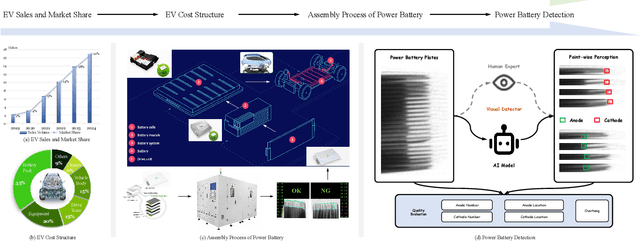
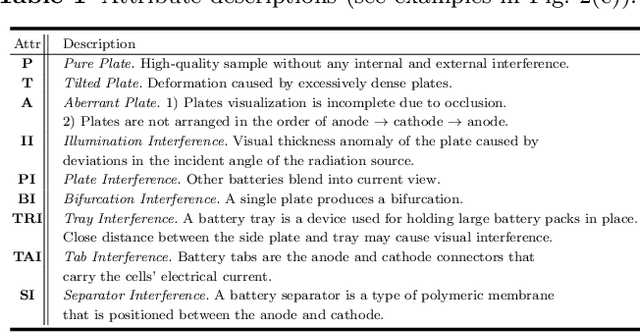
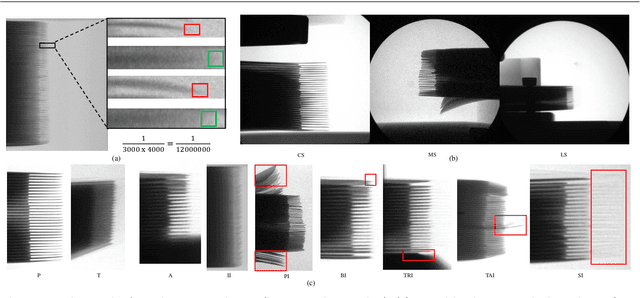

Abstract:Power batteries are essential components in electric vehicles, where internal structural defects can pose serious safety risks. We conduct a comprehensive study on a new task, power battery detection (PBD), which aims to localize the dense endpoints of cathode and anode plates from industrial X-ray images for quality inspection. Manual inspection is inefficient and error-prone, while traditional vision algorithms struggle with densely packed plates, low contrast, scale variation, and imaging artifacts. To address this issue and drive more attention into this meaningful task, we present PBD5K, the first large-scale benchmark for this task, consisting of 5,000 X-ray images from nine battery types with fine-grained annotations and eight types of real-world visual interference. To support scalable and consistent labeling, we develop an intelligent annotation pipeline that combines image filtering, model-assisted pre-labeling, cross-verification, and layered quality evaluation. We formulate PBD as a point-level segmentation problem and propose MDCNeXt, a model designed to extract and integrate multi-dimensional structure clues including point, line, and count information from the plate itself. To improve discrimination between plates and suppress visual interference, MDCNeXt incorporates two state space modules. The first is a prompt-filtered module that learns contrastive relationships guided by task-specific prompts. The second is a density-aware reordering module that refines segmentation in regions with high plate density. In addition, we propose a distance-adaptive mask generation strategy to provide robust supervision under varying spatial distributions of anode and cathode positions. The source code and datasets will be publicly available at \href{https://github.com/Xiaoqi-Zhao-DLUT/X-ray-PBD}{PBD5K}.
In-situ Value-aligned Human-Robot Interactions with Physical Constraints
Aug 11, 2025Abstract:Equipped with Large Language Models (LLMs), human-centered robots are now capable of performing a wide range of tasks that were previously deemed challenging or unattainable. However, merely completing tasks is insufficient for cognitive robots, who should learn and apply human preferences to future scenarios. In this work, we propose a framework that combines human preferences with physical constraints, requiring robots to complete tasks while considering both. Firstly, we developed a benchmark of everyday household activities, which are often evaluated based on specific preferences. We then introduced In-Context Learning from Human Feedback (ICLHF), where human feedback comes from direct instructions and adjustments made intentionally or unintentionally in daily life. Extensive sets of experiments, testing the ICLHF to generate task plans and balance physical constraints with preferences, have demonstrated the efficiency of our approach.
When and How Unlabeled Data Provably Improve In-Context Learning
Jun 18, 2025Abstract:Recent research shows that in-context learning (ICL) can be effective even when demonstrations have missing or incorrect labels. To shed light on this capability, we examine a canonical setting where the demonstrations are drawn according to a binary Gaussian mixture model (GMM) and a certain fraction of the demonstrations have missing labels. We provide a comprehensive theoretical study to show that: (1) The loss landscape of one-layer linear attention models recover the optimal fully-supervised estimator but completely fail to exploit unlabeled data; (2) In contrast, multilayer or looped transformers can effectively leverage unlabeled data by implicitly constructing estimators of the form $\sum_{i\ge 0} a_i (X^\top X)^iX^\top y$ with $X$ and $y$ denoting features and partially-observed labels (with missing entries set to zero). We characterize the class of polynomials that can be expressed as a function of depth and draw connections to Expectation Maximization, an iterative pseudo-labeling algorithm commonly used in semi-supervised learning. Importantly, the leading polynomial power is exponential in depth, so mild amount of depth/looping suffices. As an application of theory, we propose looping off-the-shelf tabular foundation models to enhance their semi-supervision capabilities. Extensive evaluations on real-world datasets show that our method significantly improves the semisupervised tabular learning performance over the standard single pass inference.
ATR-Bench: A Federated Learning Benchmark for Adaptation, Trust, and Reasoning
May 22, 2025Abstract:Federated Learning (FL) has emerged as a promising paradigm for collaborative model training while preserving data privacy across decentralized participants. As FL adoption grows, numerous techniques have been proposed to tackle its practical challenges. However, the lack of standardized evaluation across key dimensions hampers systematic progress and fair comparison of FL methods. In this work, we introduce ATR-Bench, a unified framework for analyzing federated learning through three foundational dimensions: Adaptation, Trust, and Reasoning. We provide an in-depth examination of the conceptual foundations, task formulations, and open research challenges associated with each theme. We have extensively benchmarked representative methods and datasets for adaptation to heterogeneous clients and trustworthiness in adversarial or unreliable environments. Due to the lack of reliable metrics and models for reasoning in FL, we only provide literature-driven insights for this dimension. ATR-Bench lays the groundwork for a systematic and holistic evaluation of federated learning with real-world relevance. We will make our complete codebase publicly accessible and a curated repository that continuously tracks new developments and research in the FL literature.
Oral Imaging for Malocclusion Issues Assessments: OMNI Dataset, Deep Learning Baselines and Benchmarking
May 21, 2025Abstract:Malocclusion is a major challenge in orthodontics, and its complex presentation and diverse clinical manifestations make accurate localization and diagnosis particularly important. Currently, one of the major shortcomings facing the field of dental image analysis is the lack of large-scale, accurately labeled datasets dedicated to malocclusion issues, which limits the development of automated diagnostics in the field of dentistry and leads to a lack of diagnostic accuracy and efficiency in clinical practice. Therefore, in this study, we propose the Oral and Maxillofacial Natural Images (OMNI) dataset, a novel and comprehensive dental image dataset aimed at advancing the study of analyzing dental images for issues of malocclusion. Specifically, the dataset contains 4166 multi-view images with 384 participants in data collection and annotated by professional dentists. In addition, we performed a comprehensive validation of the created OMNI dataset, including three CNN-based methods, two Transformer-based methods, and one GNN-based method, and conducted automated diagnostic experiments for malocclusion issues. The experimental results show that the OMNI dataset can facilitate the automated diagnosis research of malocclusion issues and provide a new benchmark for the research in this field. Our OMNI dataset and baseline code are publicly available at https://github.com/RoundFaceJ/OMNI.
Dual Prompting for Diverse Count-level PET Denoising
May 05, 2025Abstract:The to-be-denoised positron emission tomography (PET) volumes are inherent with diverse count levels, which imposes challenges for a unified model to tackle varied cases. In this work, we resort to the recently flourished prompt learning to achieve generalizable PET denoising with different count levels. Specifically, we propose dual prompts to guide the PET denoising in a divide-and-conquer manner, i.e., an explicitly count-level prompt to provide the specific prior information and an implicitly general denoising prompt to encode the essential PET denoising knowledge. Then, a novel prompt fusion module is developed to unify the heterogeneous prompts, followed by a prompt-feature interaction module to inject prompts into the features. The prompts are able to dynamically guide the noise-conditioned denoising process. Therefore, we are able to efficiently train a unified denoising model for various count levels, and deploy it to different cases with personalized prompts. We evaluated on 1940 low-count PET 3D volumes with uniformly randomly selected 13-22\% fractions of events from 97 $^{18}$F-MK6240 tau PET studies. It shows our dual prompting can largely improve the performance with informed count-level and outperform the count-conditional model.
Mixture-of-Shape-Experts (MoSE): End-to-End Shape Dictionary Framework to Prompt SAM for Generalizable Medical Segmentation
Apr 13, 2025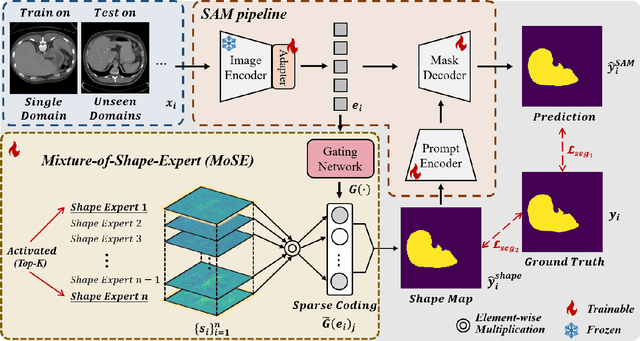

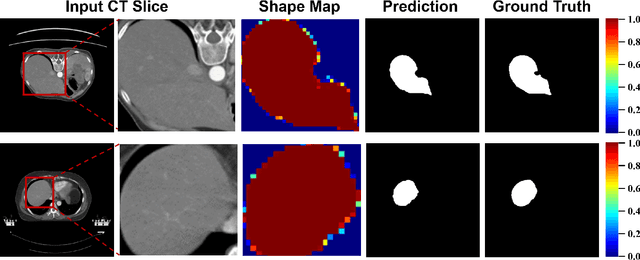

Abstract:Single domain generalization (SDG) has recently attracted growing attention in medical image segmentation. One promising strategy for SDG is to leverage consistent semantic shape priors across different imaging protocols, scanner vendors, and clinical sites. However, existing dictionary learning methods that encode shape priors often suffer from limited representational power with a small set of offline computed shape elements, or overfitting when the dictionary size grows. Moreover, they are not readily compatible with large foundation models such as the Segment Anything Model (SAM). In this paper, we propose a novel Mixture-of-Shape-Experts (MoSE) framework that seamlessly integrates the idea of mixture-of-experts (MoE) training into dictionary learning to efficiently capture diverse and robust shape priors. Our method conceptualizes each dictionary atom as a shape expert, which specializes in encoding distinct semantic shape information. A gating network dynamically fuses these shape experts into a robust shape map, with sparse activation guided by SAM encoding to prevent overfitting. We further provide this shape map as a prompt to SAM, utilizing the powerful generalization capability of SAM through bidirectional integration. All modules, including the shape dictionary, are trained in an end-to-end manner. Extensive experiments on multiple public datasets demonstrate its effectiveness.
FM-LoRA: Factorized Low-Rank Meta-Prompting for Continual Learning
Apr 09, 2025Abstract:How to adapt a pre-trained model continuously for sequential tasks with different prediction class labels and domains and finally learn a generalizable model across diverse tasks is a long-lasting challenge. Continual learning (CL) has emerged as a promising approach to leverage pre-trained models (e.g., Transformers) for sequential tasks. While many existing CL methods incrementally store additional learned structures, such as Low-Rank Adaptation (LoRA) adapters or prompts and sometimes even preserve features from previous samples to maintain performance. This leads to unsustainable parameter growth and escalating storage costs as the number of tasks increases. Moreover, current approaches often lack task similarity awareness, which further hinders the models ability to effectively adapt to new tasks without interfering with previously acquired knowledge. To address these challenges, we propose FM-LoRA, a novel and efficient low-rank adaptation method that integrates both a dynamic rank selector (DRS) and dynamic meta-prompting (DMP). This framework allocates model capacity more effectively across tasks by leveraging a shared low-rank subspace critical for preserving knowledge, thereby avoiding continual parameter expansion. Extensive experiments on various CL benchmarks, including ImageNet-R, CIFAR100, and CUB200 for class-incremental learning (CIL), and DomainNet for domain-incremental learning (DIL), with Transformers backbone demonstrate that FM-LoRA effectively mitigates catastrophic forgetting while delivering robust performance across a diverse range of tasks and domains.
 Add to Chrome
Add to Chrome Add to Firefox
Add to Firefox Add to Edge
Add to Edge